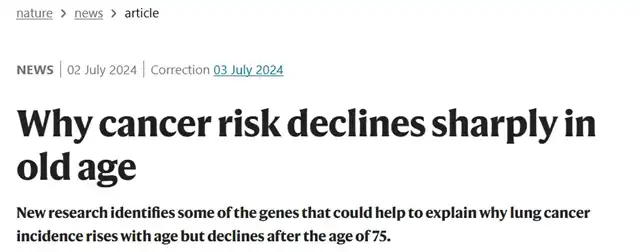Why does Mysterious Decline in Cancer Incidence After Age 75?
- Gut Bacteria’s Role in Amplifying Carcinogen Intake Leads to Distant Tumors
- TikTok Employees Experience Food Poisoning Incident: Affected Count Rises to 130
- Mixing Alcohol and Energy Drinks May Cause Long-term Brain Damage
- Water Quality Concerns Cast Shadow Over Paris Olympics Men’s Triathlon
- Have you ever tried the coffee Containing Viagra?
- Breast Cancer Bypasses Blood-Brain Barrier for Meningeal Metastasis via Neural Pathways
Why does Mysterious Decline in Cancer Incidence After Age 75?
- Should China be held legally responsible for the US’s $18 trillion COVID losses?
- CT Radiation Exposure Linked to Blood Cancer in Children and Adolescents
- FDA has mandated a top-level black box warning for all marketed CAR-T therapies
- Can people with high blood pressure eat peanuts?
- What is the difference between dopamine and dobutamine?
- How long can the patient live after heart stent surgery?
Why does Mysterious Decline in Cancer Incidence After Age 75? Nature Reveals the Reason!
Cancer, driven by accumulated DNA mutations over time, theoretically has more opportunities to arise with advancing age, as older individuals accumulate more mutations, potentially leading to unchecked growth of abnormal cells. The immune response, which may initially control tumors, also weakens with age.
Yet, tissues undergo changes as they age, which might inhibit tumor growth by altering the environment surrounding cancer cells. For instance, older lungs typically have more scar tissue, reduced regenerative capacity, and are less tolerant of the stress from disorderly growth.
Despite decades of observations, the scientific community lacks a clear explanation for the decreased cancer risk in advanced age. Researchers are exploring biological mechanisms, such as changes in gene expression and their interactions with cellular environments and metabolic processes. Understanding these mechanisms could inform new cancer treatment strategies, especially for elderly patients.
Recent Findings
Professor Heidi Ledford recently published an article in Nature, titled “Why Cancer Risk Declines Sharply in Old Age,” which reviews the potential influence of aging on the reduced incidence of lung cancer.
The article discusses gene expression changes related to aging, aiming to identify intervention strategies by understanding the biological mechanisms behind the age-related variation in cancer incidence.

Key Research Results
Studies on mice reveal unexpected benefits of aging, including a reduced cancer risk.
1. Age Accumulation: When cancer-inducing mutations were activated in the lungs of mice at different ages, younger mice developed larger tumors more frequently than older mice. This suggests a biological mechanism inhibiting tumor growth with age. Using CRISPR-Cas9 gene editing, researchers deactivated over 20 genes that typically suppress tumor growth. While tumor growth increased across all age groups, the effect was more pronounced in younger mice. In older mice, the expression of the iron metabolism-related protein NUPR1 increased, leading to an iron-deficient state that restricted cancer cell growth.
2. Iron Metabolism’s Impact: Another study led by cancer biologist Xueqian Zhuang at Memorial Sloan Kettering Cancer Center found that aging increases the production of NUPR1 in mouse and human lung cells, impacting iron metabolism. Older cells exhibit an iron-deficient state, limiting the rapid growth of cancer cells. When the Nupr1 gene was knocked out in elderly mice using CRISPR-Cas9, their lung iron levels increased, making them more susceptible to tumors, similar to younger mice. Furthermore, human lung tissue showed higher NUPR1 levels in individuals over 80 compared to those under 55, indicating a conserved mechanism between mice and humans.
3. The Stress of Cancer: Research indicates that aging can prevent tumor formation in lung cancer cells. However, significant differences may exist between human tumors and those in mice. In humans, cancer-causing mutations accumulate gradually, with the seeds of cancer potentially sown decades before tumor detection. In mice, tumors are induced by suddenly activating cancer genes in old age.
Cecilia Radkiewicz, an oncologist and tumor epidemiologist at the Karolinska Institute in Stockholm, suggests that the decline in cancer incidence with age might be an illusion. Her research shows that the apparent decrease often disappears when considering autopsy data. This suggests that cancer incidence generally remains constant in old age, but diagnosis or reporting may be less frequent in individuals over 75. Lung cancer is an exception, with incidence declining even when accounting for autopsy data.
Conclusion and Implications
These findings underscore the importance of studying cancer in older mice, revealing new perspectives for treating cancer in both young and elderly patients. They highlight crucial targets for regenerative medicine.
Editor’s Note: This report uncovers the unexpected decline in lung cancer risk after age 75, suggesting unique tumor suppression mechanisms in elderly patients that could inform targeted treatments. It also points to lower cancer diagnosis and reporting rates among the elderly, urging enhanced cancer screening efforts in this demographic. Identifying genes related to reduced lung cancer risk, especially those involved in iron metabolism, offers new insights into how aging affects tumor microenvironments. Additionally, improving cancer screening and epidemiological research methods is essential for accurately assessing cancer incidence in the elderly.
For the original article, visit: https://doi.org/10.1038/d41586-024-02107-z
Why does Mysterious Decline in Cancer Incidence After Age 75?
(source:internet, reference only)
Disclaimer of medicaltrend.org
Important Note: The information provided is for informational purposes only and should not be considered as medical advice.



